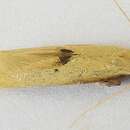Comprehensive Description
provided by Smithsonian Contributions to Zoology
Opogona arizonensis
ADULT (Figure 3).—Moderately small, with slender, predominantly stramineous forewings bearing a single small, triangular, fuscous spot midway along hind margin.
Wing Expanse: , 11.5–16 mm; , 12.5–15 mm.
Head: Vestiture generally uniformly yellowish white and smooth; posterior portion of vertex smooth to occiput; scales between antennal sockets raised into a low, rounded ridge that slightly overhangs upper portion of frons; scales of frons smooth, closely appressed. Antennae approximately 0.65–0.7 the length of forewing, 64–67 segmented; scape slightly flattened and concave on ventral surface, vestiture tawny, heavily suffused with fuscous; flagellum uniformly stramineous except for slight fuscous suffusion occasionally present over basal 2–3 segments; one row of relatively narrow, appressed scales per segment. Maxillary palpi whitish, densely pubescent ventrally. Labial palpi whitish above, heavily suffused with fuscous ventrally and over apical segment.
Thorax: Pronotum stramineous; meso- and metanota mostly naked; tegulae stramineous above, fuscous below. Venter whitish. Pro- and mesothoracic legs predominantly white ventrally, heavily suffused with fuscous above; metathoracic legs entirely white to stramineous. Forewings entirely stramineous except for fuscous suffusion along base of costal margin and a prominent, triangular fuscous spot near middle of hind margin; fringe stramineous; ventral surface brownish fuscous. Hind wings pale gray above and below, more thinly scaled than forewings.
Abdomen: Stramineous to grayish fuscous above; usually paler beneath, stramineous to whitish; seventh segment of female with a dense encirclement of elongate stramineous hair.
Male Genitalia (Figures 111–114): Uncus deeply divided into two large, widely separated lobes bearing numerous, stout, elongate spinose setae on their mesal surfaces. Tegumen reduced to a relatively narrow, dorsal ring. Vinculum expanded posteriorly as well as anteriorly into a quadrate plate; saccus very slender, rod shaped, approximately 0.7 the length of valva. Valvae essentially undivided but with a prominent, rounded subapical lobe from costa bearing a dense cluster of elongate spinose setae mesally. Anellus relatively weak, more sclerotized ventrally than dorsally. Aedeagus simple, straight, moderately slender, without cornuti.
Female Genitalia (Figure 127): Tertiary apophyses faintly present. Genital plates deeply lobed with ostium bursae situated ventrad to lobes. Corpus bursae with a relatively large pair of thornlike signa.
HOLOTYPE.—, 24 July 1959, coll. R. W. Hodges, Madera Canyon, Santa Rita Mts, 4880 ft [1488 m], Arizona, USNM 72095; in the National Museum of Natural History, Smithsonian Institution.
PARATYPES.—UNITED STATES. ARIZONA: Cochise Co: Carr Canyon, 5000 ft [1524 m], Huachuca Mts: 2 , 21 May 1977, coll. R. Wielgus (USNM). Guadelupe Canyon, Peloncille Mts: 2 , 8 Nov 1975, coll. R. Wielgus (USNM). Palmerlee: 1 , 2 , genitalia slide USNM 18424, leg slide USNM 20742 (USNM). Paradise [Chiricahua Mts]: 1 , 3 , May-Aug (USNM). Pima Co: Madera Canyon, Santa Rita Mts, 4400 ft [1341 m]: 3 , 12 Oct 1959, coll. R. Hodges (USNM); 1 , 18 Oct 1959 (UCB); 4880 ft. [1488 m]: 1 , 12 Oct 1959 (BMNH); 5 , 4 , 7 Jul-25 Oct 1959, genitalia slide USNM 16547; genitalia slides USNM 16548, 18421 (USNM); 1 , 4 Aug 1959 (UCB); 5600 ft [1707 m]: 1 , 1 Aug 1959 (USNM). TEXAS: Brewster Co: K Bar Ranch, Chisos Mts: 1 , 2 Jun 1973, coll. R. Hodges, genitalia slide USNM 20254 (USNM). Described from a total of 9 males and 25 females.
HOST.—Unknown.
FLIGHT PERIOD.—May to October; apparently multivoltine.
DISTRIBUTION (Map 1).—Presently known only from southeastern Arizona and extreme southern Texas but undoubtedly ranging farther south into Mexico.
- bibliographic citation
- Davis, Donald R. 1978. "The North American Moths of the General Phaeoses, Opogona, and Oinophila, with a Discussion of their Supergeneric Affinities (Lepidoptera: Tineidae)." Smithsonian Contributions to Zoology. 1-39. https://doi.org/10.5479/si.00810282.282

